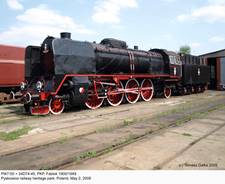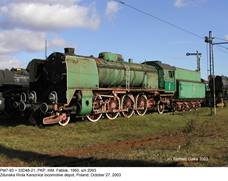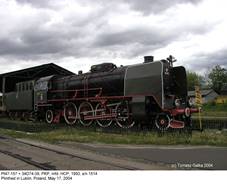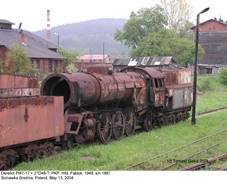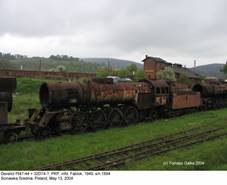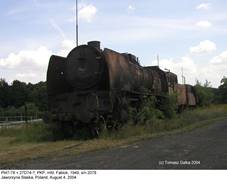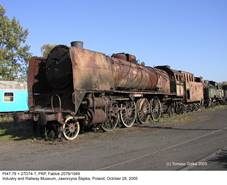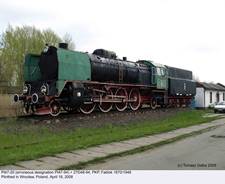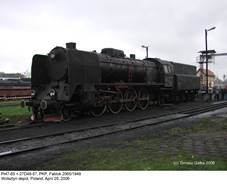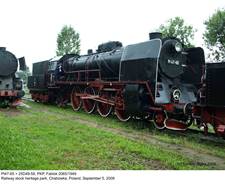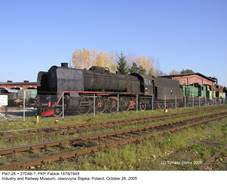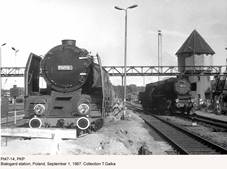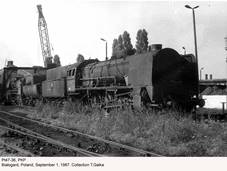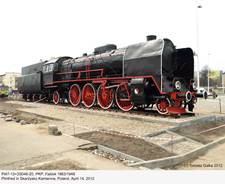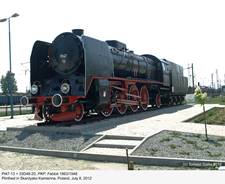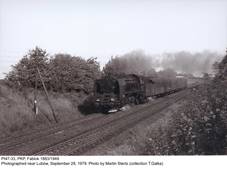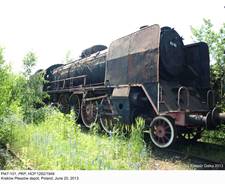Pt47
|
|||||||||||||||||||||||||||||||||||||||||||||||||||||||||||||||||||||||||||||||||||||||||||||||||||||||||||||||||||||||||||||
|
Pt47-129, photographed at the Wrocław Główny depot in August 1961.
Photo from my collection. Pt47-152 + 33D48-7 (HCP
1402/1950), photographed in Chabówka, Another photo of this engine, taken on This Pt47-171 + 33D48-8 (Fablok 2111/1950) is erroneously
designated Pt47-100. Photo taken in Kościerzyna in August 2000. Another photo of the Pt47-171, taken twenty years later, on August 12,
2020. Hopefully a refurbishment will follow… These who visit this page often probably know
this photo: Pt47-112 + 34D74-42 (HCP
1310/ 1949), Wolsztyn, The same machine photographed during the ‘Steam Locomotives Parade’ in
April 2005 – note different tender. This engine participated in the steam
locomotives parade in Chabówka on July 29, 2006 – some photos are here. On April 28, 2007, Pt47-112 again
participated in the Parade... ...but this time with 27D48-57 tender, which
is much more typical (previously coupled with Pt47-65). Pt47-112 appeared also at the 2008 Show;
photo taken on May 3. Another machine from Wolsztyn: Pt47-106 +
27D47-22 (HCP 1304/1949) on static
display, photographed on September 8, 2004. Pt47-50 + 34D74-45 (Fablok 1900/1949) plinthed in Siedlce,
photographed on June 1, 2003: sad example of the lack of respect… …but things sometimes improve:
in October 2006 this engine was transferred to Pyskowice and now is a
part of the TOZKiOS collection. Photo taken on May 2, 2009. Pt47-93 + 33D48-21 (Fablok
2093/1950), Zduńska Wola Karsznice depot, photographed on October 27, 2003. Pt47-157 + 34D74-39 (HCP
1514/1950) plinthed in Lublin, May 17,
2004. Another picture of this locomotive, taken on July 29, 2017. Derelict Pt47-17 + 27D48-? (Fablok 1867 /1948), photographed in
Ścinawka Średnia on May 13, 2004… … and wreck of Pt47-44 +
32D74-?, (Fablok 1894/1949), photographed on the same occasion. Derelict Pt47-78 + 27D74-? (Fablok
2078 /1949) in Jaworzyna Śląska, photographed on August 4, 2004… …and the same engine photographed there on October 28, 2005. Pt47-20 + 27D48-94 (erroneous designation Pt47-94, Fablok
1870/1948), plinthed in Wrocław,
April 18, 2008. Pt47 with 27D48 tender; side drawing from PNP. Pt47-65 + 27D48-57 (Fablok
2065/1949), photographed during the ‘Steam Locomotives Parade’ at Wolsztyn
depot, April 30, 2005. More photos of the Pt47-65 can be found here. In late 2005, Pt47-65 was withdrawn from
service. This picture was taken in Wolsztyn on April 29, 2006. Fortunately, this withdrawal was only
temporary. This picture was taken during the ‘Parowozjada 2009’ in Chabówka
on September 5, 2009. This Pt47-28 + 27D48-? (Fablok
1878/1949) was transferred to the Industry
and Railway Museum in Jaworzyna Śląska in 2005 from Gniezno depot (where
it was probably intended for cannibalization); photo taken on October 28,
2005. Pt47-104 + 32D74-54 (HCP
1302/1949), Railway Museum, Warsaw, September 5, 2006. Two pictures, taken in Białogard on September 1, 1987: Pt47-14,
alongside with the Ty2-617... ...and Pt47-36. Photos from my collection. Pt47-150 (HCP 1390/1949), probably withdrawn, photographed in
Kłodzko in 1987. Photo by PhotoGataR (from my collection). Pt47-13 (Fablok 1863/1948), withdrawn in 1988, was initially
plinthed in Bielsko-Biała. Transferred to the Kraków Płaszów depot in 2001,
it was moved to Skarżysko Kamienna in 2011 and plinthed near the railway
station on April 13, 2012, with the 33D48-20 tender. This photo was taken on
the next day – motion gear and plates are still missing. Pt47-13 was
officially ‘unveiled’ on April 19. Pt47-13 again, after the whole place has been tidied up and some
missing elements fitted: July 8, 2012. Two photos by Martin Stertz (from my collection): Pt47-134 (HCP
1336/1949), photographed near Tuplice on January 13, 1983… …and Pt47-33, photographed near Lubów on September 28, 1979. Pt47-101 (HCP 1282/1949) is currently kept at the Kraków
Płaszów depot. Photo taken on June 20, 2013. Pt47-1 + 33D44-1, factory photo. Although this engine was built by Fablok
(1851/1948), this photo was used in a HCP
leaflet. From my collection. |
Pt31
express engine, of which 110 were built between 1932 and 1940, is considered
by many the best pre-war Polish locomotive. After WWII, Polish railways
regained only 66 examples, most of them between 1947 and 1948. Lack of
express locomotives was particularly acute. Initially it was intended to
introduce new normalized types, but their development would have been lengthy
and complex. In order to speed up deliveries, as early as in 1947 it was
decided to re-commence production of modified Pt31 at both HCP and Fablok. New
variant was designated Pt47 and differed from its predecessor in several
details. Boiler was fitted with steel firebox and circulation tubes; later
rocking grate was introduced. Distance between tube walls was shortened by
100 mm and evaporating surface was marginally reduced, but with two more
smoke tubes superheater surface was increased by
almost 10%. Boiler fittings were modified. Frame was thoroughly redesigned
and empty locomotive, without tender, was lighter by two tonnes.
Externally, Pt47 differed from Pt31 mainly in having steam and sand domes
covered by a single fairing, different smoke lifters and fully enclosed
driver’s cab. A semi-streamlined version, heavier by about four tonnes, was also proposed by Fablok
shortly after production had commenced, but was not accepted and did not
progress beyond preliminary design stage. Pt47s
were coupled with a variety of tenders. Initially, 34D48 tenders were used
which, in fact, were slightly modified 34D44s of German origin (DRG
2’2’T34), with enlarged coal boxes. Later, probably from Pt47-91 onwards,
indigenous 33D48s became standard, but their journal axle bearings were prone
to overheating. Some of them, fitted with coal feeders, were re-designated
26D48, later rebuilt and re-designated 27D48. Modified tenders with roller
axle bearings, much more suitable for high speed, became 34D74 (without coal
feeders) and 27D74 (with coal feeders). Finally, rebuilt 32D29 tenders from
Pt31 were re-designated 32D74. Tests with 32D47 tub tenders (the same as used
with Ty45 freighters) were not successful, due to uneasy running above 80
km/h. Prototype
was built by Fablok in 1948 (s/n 1851).
Initial orders included 100 examples from Fablok and 35 from HCP. In 1950 additional orders were
placed with both manufacturers, for 20 and 25 examples, respectively.
Production was terminated in 1951. These locomotives were built exclusively
for PKP and soon earned a reputation comparable to that of Pt31s – of
good, powerful and reliable machines. Most new Pt47s were directed to
principal lines throughout the country and were often used with heavy drafts.
As electrification progressed, they were from mid-1970s – together with other
steam locomotives – relegated to secondary duties, but in 1980 PKP
rosters still included 156 examples and four years later 144. In late 1980s,
however, their number rapidly dwindled and last of them, Pt47-13, was
withdrawn from active service in October 1988. One example (Pt47-134, HCP
1336/1949) was transferred to a food industry plant in 1985, subsequently
serving as a stationary boiler for several years. Two more, Pt47-11 and
Pt47-48, survived in this unconspicious role at the
Lublin depot until 1996. According
to lists compiled by Tomisław Czarnecki
(available at www.holdys.pl/tomi), 21
Pt47s still existed in Poland early 2005, although one-third of them merely
as wrecks. Two derelict engines (Pt47-2, Fablok 1852/1948, and Pt47-105,
HCP 1303/1949) were scrapped in September 2005. Two more, dumped in Ścinawka Średnia (Pt47-17, Fablok 1867/1948,
and Pt47-44, Fablok
1894/1949) followed soon. Two machines, based in Wolsztyn,
were kept operational for quite a long time. Pt47-65 (Fablok
2065/1949) is a well-known locomotive which often ran with scheduled trains.
In August 2012 it was transferred to Chabówka for a
major repair, or more appropriately a reconstruction. Many elements and
sub-assemblies had to be made from scratch and the engine was outshopped only in April 2016. Pt47-112 (HCP 1310/1949) was
restored in service in 1989. In early 2005 it was fitted the 25D49-98 tender,
as used with Ol49s – albeit bearing 34D74-42 designation! The aim was to
match the 20 m turntable at Wolsztyn depot (axle
base of the ‘new’ tender is shorter by 850 mm), but railway purists used to
grind their teeth. It has to be mentioned that immediately before major
repair Pt47-65 was also coupled with a 25D49. In 2007 Pt47-112 was fitted
with ‘standard’ tender, previously coupled with Pt47-65, erroneously numbered
27D47-58. Unfortunately in 2008 this engine was ultimately withdrawn from use
and is now kept in Wolsztyn on static display.
Initially it was intended to maintain Pt47-28 (Fablok
1878/1949) in working order, but finally this machine was used as the
source of spares for two operational examples. Each of principal Polish
railway museums or heritage parks has a Pt47: Warsaw Railway Museum
(Pt47-104, HCP 1302/1949), Industry and Railway Museum in Jaworzyna Śląska (Pt47-78, Fablok 2078/1949, albeit in a poor condition), Zduńska Wola Karsznice locomotive depot (Pt47-93, Fablok
2093/1950), Chabówka heritage park (Pt47-152, HCP
1402/1950) and Kościerzyna locomotive depot
(Pt47-171, erroneously designated Pt47-100, Fablok
2111/1950). Several engines (including prototype Pt47-1) are plinthed at various locations. One
more locomotive of this type was kept operational for some time. Pt47-138 (HCP
1340/1949), after withdrawal, was sold to Austrian Brenner & Brenner tourist railway (named after
proprietors, not Brennerpass!). This machine was
externally made similar to Pt31 (boiler domes fairing was removed and smoke
lifters were modified), to commemorate service of the latter type as class
919 with Austrian railways during WWII and shortly afterwards. After
undergoing a major overhaul in Česke Velenice (Czech Republic) in 2000, this engine joined the
B&B fleet as 919.138, becoming the company’s most powerful
locomotive. Its last reported service was in September 2006. Pt47
crowned the development of express steam locomotives in Poland. Built to
fulfill virtually the same demands as Pt31, it was designed not for extreme
speed, but rather high tractive effort with moderate axle load. For that
purpose, four coupled axles were used; axle load was only by 0.5 tonne higher than in much lighter Pacific Pm36,
but tractive effort was higher by over 27%. Contrary to many European
railways (including Germany and UK), express Pacifics
were not favored by PKP: three coupled axles did not allow to keep
axle load within acceptable limits, while single-axle lead truck was
sufficient for speeds up to 100 km/h. Mikados
were much better suited for specific Polish conditions, where few lines were
suitable for high speed traffic and, at the same time, good acceleration with
heavy drafts was demanded. In such service, Pt47s performed very well. Main technical data
1)
27D48 = 33D48 with coal feeder, 34D48 = 34D44 with
modified couplings, 27D74 = 27D48 with roller axle bearings, 34D74 = 34D48
with roller axle bearings, 32D74 = modified 32D29 2)
With 33D48 tender (from 1949 onwards – starting
probably with Pt47-91) 3)
With 34D48 tender References
and acknowledgments
-
PNP, PNPP, AP, EDÖ; -
monographic article by Paweł
Terczyński and an article on the Pt47-65
reconstruction by Andrzej Nowak (SK
vol. 5/2016); -
http://parowozy.best.net.pl
(website by Michał ‘Doctor’ Pawełczyk); -
SK, various issues. |
||||||||||||||||||||||||||||||||||||||||||||||||||||||||||||||||||||||||||||||||||||||||||||||||||||||||||||||||||||||||||||












